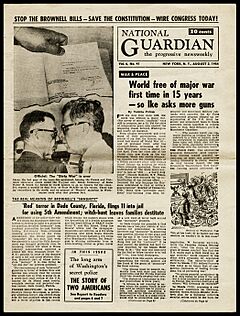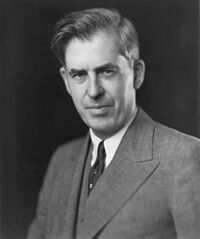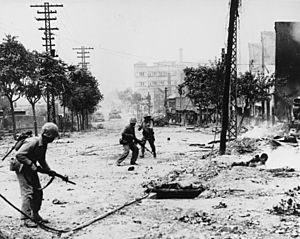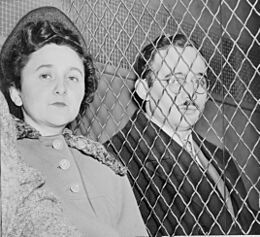National Guardian facts for kids
| Independent radical newsweekly | |

A typical front page of the National Guardian during the McCarthy era
|
|
| Type | weekly |
|---|---|
| Format | tabloid |
| Founder(s) | James Aronson Cedric Belfrage John T. McManus |
| Founded | 1948 |
| Political alignment | Socialism, Anti-militarism, New Left/Maoism (1968-1992) |
| Ceased publication | 1992 |
| ISSN | 0362-5583 |
| OCLC number | 4564405 |
The National Guardian, later called The Guardian, was an independent weekly newspaper that started in 1948 in New York City. It was founded by James Aronson, Cedric Belfrage, and John T. McManus. They started the paper around the time of the 1948 Presidential campaign of Henry A. Wallace.
Even though it was independent, the National Guardian was initially thought to be close to the Communist Party USA. However, this connection changed over several years. In 1968, the newspaper changed its name to The Guardian and started to support Maoism and the New Communist Movement in the United States.
In the early 1980s, the paper's focus shifted again, becoming more generally radical but not strictly communist. The Guardian stopped publishing in 1992 because it had fewer readers and faced money problems.
Contents
History of the National Guardian
How the Newspaper Started
In the 1930s, the Communist Party USA (CPUSA) was the biggest Marxist political group in the United States. They published a daily newspaper in English called the Daily Worker. This paper was controlled by the party, which limited its appeal to many thinkers.
After World War II ended in 1945, some American journalists went to Germany. Their job was to help remove people who had supported the Nazi regime from the German newspaper industry. They also helped set up new democratic newspapers. Among these journalists were James Aronson from New York City and Cedric Belfrage from England.
Aronson and Belfrage shared similar political ideas. They talked about starting a new radical newspaper in the United States after the war. This plan didn't happen right away, as they both returned to their lives in the U.S.
Connection to the Progressive Party
Many American thinkers were unhappy with President Harry S. Truman. They didn't like his strong stance against the Soviet Union or his lack of commitment to social programs. So, they looked for a different choice in the 1948 United States presidential election.
This led to a new political group called the Progressive Party. They launched a national campaign with former Vice President Henry A. Wallace as their leader. The Communist Party USA also supported Wallace's campaign.
James Aronson and Cedric Belfrage were active in Wallace's campaign. They met again and decided to restart their plan for an independent radical newspaper. They were joined by John T. McManus, who had worked for the newspaper PM. They were also joined by Josiah Gitt, who published a liberal newspaper in York, Pennsylvania.
In July 1948, these four people created a sample paper called The National Gazette. They shared it at the Progressive Party Convention. People at the convention liked the idea and promised to subscribe. Gitt soon left the project, so Aronson, Belfrage, and McManus continued alone. Aronson became the Executive Editor, Belfrage the Editor, and McManus the Managing Editor.
Starting the Newspaper
The first issue of the National Guardian was printed on October 18, 1948. This was just three weeks before the presidential election. The paper called itself a "progressive weekly." It said it supported the "progressive tradition" of Franklin D. Roosevelt, but with a clear socialist viewpoint.
The paper first looked like weekly news magazines such as Time and Newsweek. It had sections like "The Nation," "The World," and "Sports." Instead of "Business," it covered the labor movement under "Labor's Week." This section style was soon dropped, except for a "Better Living" section. The paper didn't have a separate editorial page. Instead, it showed its opinions through the news stories it chose and rewrote from other sources.
Many different radical writers contributed to the National Guardian early on. These included NAACP founder W. E. B. Du Bois, writer Ring Lardner, Jr., and journalist Anna Louise Strong. The first issue even had articles by young novelist Norman Mailer and Henry Wallace himself. The paper became known for its unique foreign news, with reports from Strong and other veteran journalists like Agnes Smedley.
Newspaper Readership
The National Guardian started with 5,000 copies. It was very popular at first, and by the end of its first year, it was printing almost 100,000 copies. The editors hoped to grow even more and reach 500,000 or even 1,000,000 copies. Since over a million people voted for Henry Wallace in 1948, this goal seemed possible.
However, the paper's early money came from a one-year grant from Anita McCormick Blaine. When this money ran out, the paper faced financial problems. It cost 12 cents to make each issue, but it sold for only 5 cents. The paper had to skip some issues and cut staff pay to survive. The price was then raised to 10 cents.
The National Guardian's growth was also hurt because it was linked to a political movement that was losing support. The Progressive Party, which was damaged by its connection to Henry Wallace and criticism for its suspected ties to the Communist Party, ended in the 1950s. Also, the American Labor Party (ALP), which the National Guardian strongly supported, lost many followers.
A big blow came in 1950 with the start of the Korean War. The National Guardian strongly opposed this war. Because it was accused of having Communist sympathies, the newspaper's readership dropped sharply. It fell to 50,000 by 1951. Readership continued to decline during the "Second Red Scare" and McCarthyism. It went down to 45,000 in 1953, 35,000 in 1957, and just 29,000 in 1961.
Main Topics Covered
The National Guardian regularly covered several important topics in the 1950s and 1960s. A main focus was its opposition to the Cold War and military actions. It was one of the few public voices against the Korean War. The paper also supported new anti-colonial movements in Africa and Asia. Reporters were sent abroad to cover these movements firsthand.
The paper was also very involved in defending controversial American figures during the McCarthy era. This included Julius and Ethel Rosenberg, Alger Hiss, and the Hollywood Ten. The National Guardian's coverage of the Rosenberg case was especially strong. The paper helped organize their legal defense when other groups were trying to distance themselves from the case.
A third important area for the National Guardian was the ongoing Civil Rights Movement in America. It covered efforts to end segregation in schools, expand voting rights, stop discrimination in housing and jobs, and resist violent acts. The paper worked closely with important Black thinkers like W. E. B. Du Bois and singer Paul Robeson.
Throughout this time, the National Guardian kept friendly ties with the Communist Party USA. It generally supported similar anti-military views. The paper differed from the Communist Party mainly on the idea of independent political action. The National Guardian continued to support this, even when the Communist Party had stopped. More differences appeared after Khrushchev's Secret Speech of 1956. The paper supported Yugoslav independence and tried to report honestly on events in Eastern Europe and the Hungarian Revolution.
In the 1960s, the paper became known for its independent and investigative journalism. This included important work by Joanne Grant on the Civil Rights Movement.
New Name and New Direction
As the 1960s continued, the United States became deeply involved in the Vietnam War. The Civil Rights Movement also grew stronger with the rise of Black nationalism and the Black Panther Party. A new youth movement, called the New Left, emerged. This included groups like Students for a Democratic Society (SDS). This new movement often preferred direct actions like street protests over traditional politics.
The National Guardian changed with these times. However, there was also disagreement within the paper between James Aronson and a new generation of staff. These new staff members wanted the paper to be more radical and active. The change happened in February 1968. Aronson sold his share of the paper to the staff, and the paper was reorganized under new leaders and a new name: The Guardian.
Some things stayed the same, like foreign correspondents Anna Louise Strong in China and Wilfred Burchett in Southeast Asia. Jack A. Smith became the editor of the new Guardian and stayed for 13 years until 1981. The new Guardian focused more on revolutionary events in the People's Republic of China and struggles against colonialism in the Third World. For American news, the new Guardian aimed to "build a radical movement." The staff proudly said, "We are movement people acting as journalists."
In 1970, a disagreement among the editorial staff led to a short-lived rival paper called the Liberated Guardian. This hurt The Guardian, and its readership fell to just 14,000.
Political Activities
In the 1970s, The Guardian openly supported a Marxist–Leninist idea. This was linked to the Maoist New Communist Movement. The paper called for a new Marxist–Leninist party in the United States. The paper tried to be independent and didn't formally join any specific group. It also criticized the many small New Left party groups that appeared after SDS ended in 1970. The original National Guardian's focus on straight news reporting changed. In the 1970s, the paper included more opinions and commentary.
These efforts to build a new party didn't succeed. This was partly because the Cultural Revolution in China lost steam. Also, there wasn't much public support for extreme political ideas in the United States. By the 1980s, the paper started to be less extreme. It supported revolutionary movements of all kinds, regardless of the split between China and the Soviet Union. It also allowed different views from many political activists. Readership recovered somewhat, staying between 20,000 and 30,000 copies.
In the early 1980s, the paper started "Guardian Clubs" for readers. They even discussed forming a new political party. After a disagreement, Guardian executive editor Irwin Silber left the paper. He started a new group around the Guardian Clubs. This group published the Frontline newspaper, which competed with The Guardian.
William A. Ryan took over as editor after Jack Smith. Ryan tried to continue The Guardian's independent New Left approach. He sometimes supported revolutionary movements that the Soviet Union didn't favor, such as in Western Sahara and Eritrea. Under Ryan, The Guardian changed its tax status to a non-profit organization. It tried to get support from foundations to make up for money lost to the Frontline group.
Final Years
With the rise of the Green Party in Germany and other countries, some Guardian writers tried to make the paper support the Green Party. However, this effort was not successful.
The Guardian stopped publishing in 1992. This was after many years of money problems and fewer readers.
Organization
Correspondents for the paper included George Shaw Wheeler in Prague.
See also
- Alternative media (U.S. political left)
- Progressive Party
- National Committee to Secure Justice in the Rosenberg Case
- New Communist Movement




